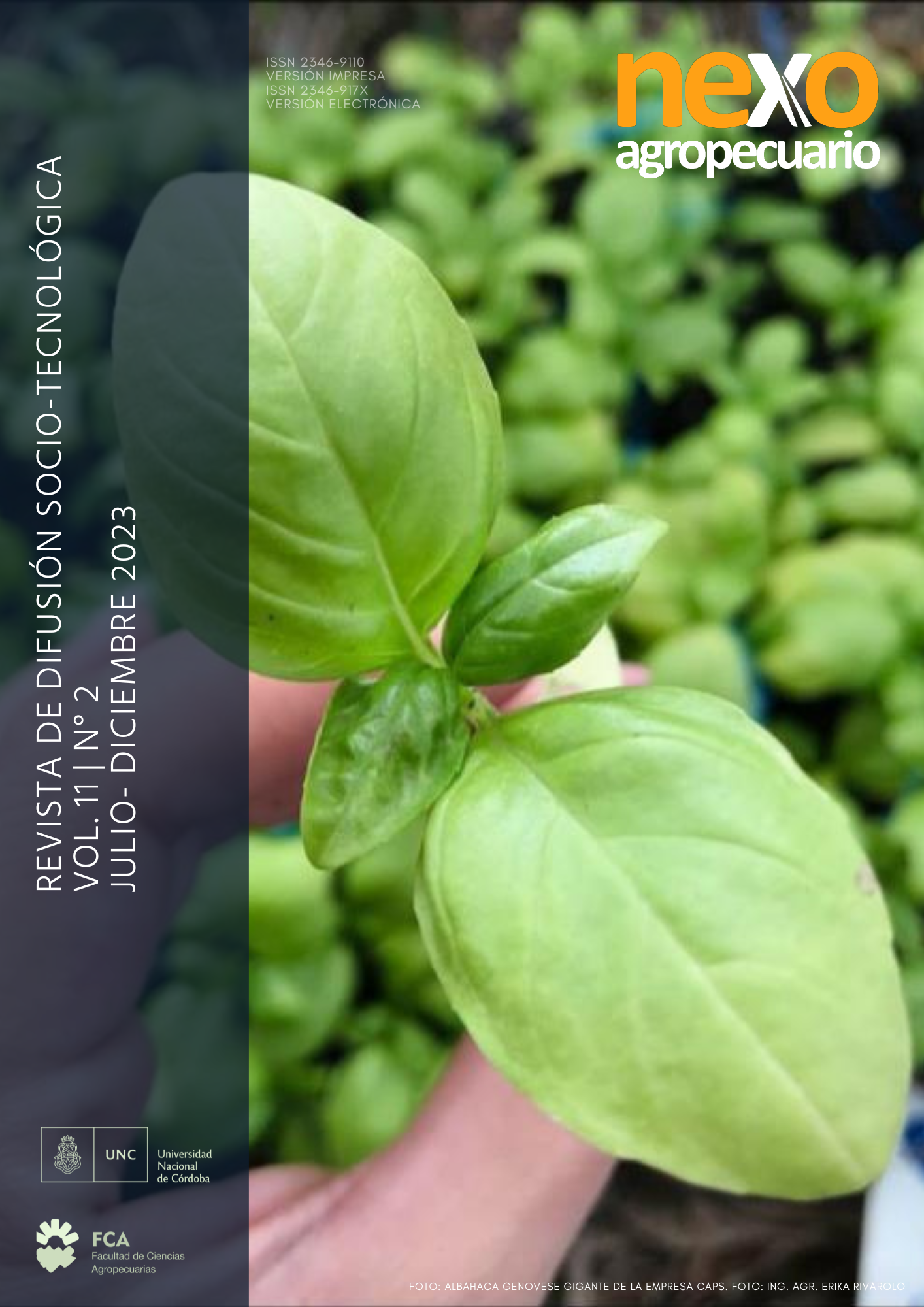MAPEO DE LA INTENSIFICACIÓN AGRÍCOLA EN CÓRDOBA MEDIANTE SERIES TEMPORALES DE NDVI
Palabras clave:
simple/doble cultivo, soja, trigo, maíz, NDVI-MODISResumen
En la actualidad los agricultores deben tomar decisiones respecto a la elección de variedades, sistemas de rotación, de manejo y si sembrar uno o más cultivos en un mismo año. En Córdoba los cultivos predominantes son trigo, soja y maíz, sembrados en secuencias de un único cultivo anual (SC) o doble (DC), como trigo-soja o trigo-maíz. El objetivo de este trabajo fue desarrollar y evaluar un nuevo método: la Envolvente de Clasificación (EC) para identificar presencia de SC o DC, utilizando series temporales NDVI - MODIS. La calibración y validación se realizó utilizando datos de campo adquiridos entre 2015 y 2018. Se determinó la pertenencia a cada clase cuando al menos el 50% de los valores de la firma de NDVI se encontraban dentro de los perfiles temporales de SC o DC, con una diferencia positiva entre las clases. Los resultados mostraron una exactitud global entre 96% y 98% y coeficientes Kappa de 91% a 97%. Al aplicar la EC, la detección de superficies con DC varió de 18.3% a 28.7%, mientras que las de SC disminuyó de 64% a 49.5% durante el periodo analizado. EC es un método simple y altamente preciso para detectar la intensidad del uso de la tierra.
Referencias
Aliaga VS, Ferrelli F. y Piccolo MC. 2017. Regionalization of climate over the Argentine Pampas. Int J Climatol 37: 1237–1247.
Andrade, J. F., S. L. Poggio, M. Ermacora, and E. H. Satorre. 2017. “Land use intensification in the Rolling Pampa, Argentina: Diversifying crop sequences to increase yields and resource use”. European Journal of Agronomy 82: 1–10. doi:10.1016/j.eja.2016.09.013.
Cassman, K.G., and P. Grassini. 2020. “A global perspective on sustainable intensification research”. Nature Sustainability 3 (4): 262–268. doi:10.1038/s41893-020-0507-8.
Chialvo E, Herrero RM, Mir LR, Pronotti MS, Mansilla, GJ (2021) Productividad y calidad de la soja en la zona núcleo-sojera. Campaña 2020/21. Ediciones INTA. Disponible en: https://inta.gob.ar/documentos/revista-idia-21-0
De Castro AI, Six J, Plant RE and Peña JM. 2018. Mapping crop calendar events and phenology-related metrics at the parcel level by object-based image analysis (OBIA) of MODIS-NDVI time-series: a case study in central California. Remote Sensing 10 (11): 1745.
García CL, Piumetto M, Teich I, Morales H, Kindgard A, Fuentes ML y Ravelo A. 2018. Mapas de cobertura del suelo de la Provincia de Córdoba 2017/2018–Niveles 1 a 3. Infraestructura de Datos Espaciales de Córdoba (IDECOR). Disponible en: https://www.idecor.gob.ar/wp-content/uploads/2019/04/Informe-tecnico_Mapa_Cobertura_del_Suelo.pdf
Gorelick N, Hancher M, Dixon M, Ilyushchenko S, Thau D. and Moore R. 2017. Google Earth Engine: Planetary-scale geospatial analysis for everyone. Remote Sens. Environ. 202: 18–27
Guo Y, Xia H, Pan L, Zhao X and Li R. 2022. Mapping the northern limit of double cropping using a phenology-based algorithm and Google Earth Engine. Remote Sensing 14 (4): 1004.
He S, Peng P, Chen Y. and Wang X. 2022. Multi-Crop Classification Using Feature Selection-Coupled Machine Learning Classifiers Based on Spectral, Textural and Environmental Features”. Remote Sensing: 14(13), 3153.
MAGyP. Presidencia de la Nación 2021. “Estimaciones Agrícolas.” Disponible en: https://datosestimaciones.magyp.gob.ar/reportes.php?reporte=Estimaciones.
Nolasco MM, Ovando G, Sayago S, Magario I. y Bocco M. 2021. Estimating soybean yield using time series of anomalies in vegetation indices from MODIS. Int J Rem Sens 42: 405–421.
Ovando G, Sayago S, Bellini Y, Belmonte ML y Bocco M. 2021. Precipitation estimations based on remote sensing compared with data from weather stations over agricultural region of Argentina pampas. Remote Sensing Applications: Society and Environment 23: 100589.
Pan L, Xia H, Yang J, Niu W, Wang R, Song H, Guo Y, Qin Y. 2021. Mapping cropping intensity in Huaihe basin using phenology algorithm, all Sentinel-2 and Landsat images in Google Earth Engine. Int J Appl Earth Obs Geoinf 102: 102376.
Piccinetti, C.F., S. Bacigaluppo, C.A. Di Ciocco, J.M. De Tellería, and Salvagiotti F. 2021. “Soybean in rotation with cereals attenuates nitrous oxide emissions as compared with soybean monoculture in the Pampas region”. Geoderma 402: 115192. doi:10.1016/j.geoderma.2021.115192.
Videla-Mensegue, H, O.P. Caviglia, A. Degioanni, J. Marcos, and E. Bonadeo. 2021. “Modelling water productivity for ecological intensification of crop sequences in the Inner Argentinean Pampas”. Field Crops Research. 271: 108246. doi:10.1016/j.fcr.2021.108246.
Yang Y, Ren W, Tao B, Ji L, Liang L, Ruane AC, Fisher J, Liu J, Sama M, Li Z. and Tian Q. 2020. Characterizing spatiotemporal patterns of crop phenology across North America during 2000–2016 using satellite imagery and agricultural survey data. ISPRS J. Photogrammetry Remote Sens. 170: 156–173.
Descargas
Publicado
Número
Sección
Licencia
Derechos de autor 2023 Miguel Nolasco, Gustavo Ovando, Silvina Sayago, Mónica Bocco

Esta obra está bajo una licencia internacional Creative Commons Atribución-NoComercial-CompartirIgual 4.0.
Atribución – No Comercial – Compartir Igual (by-nc-sa): No se permite un uso comercial de la obra original ni de las posibles obras derivadas, la distribución de las cuales se debe hacer con una licencia igual a la que regula la obra original.


